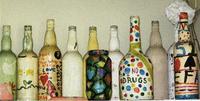Michael Robinson, Gleaner Writer 
Pieces of art created by participants in UWI's occupational therapy programme. - Photos by Michael Robinson
THE ASSOCIATION between art and the functioning of the mind is a story that has spanned centuries. Many talented artists throughout history have been associated with mental illness, the most famous being Dutch painter Vincent van Gogh. As a treatment for mental illness, however, art has only come into its own relatively recently.
Art therapy emerged as a distinct profession within the field of psychology, both in the United States and the United Kingdom, in the 1940s. In Jamaica, it was established in 2001 at the University of the West Indies (UWI) as a treatment for patients with schizophrenia, bipolar disorder and depression. Art offers a mode of expression for those who may be unable or unwilling to voice their innermost thoughts and feelings. The quiet focus involved in the process also acts as a form of meditation.
Standard objective tests

Art Therapy
Art therapists have at least a master's degree in art therapy as well as experience with art and the creative process. They use the creative output of the patients to assess their mental states by way of qualitative tests. Therapists also use standard objective tests to track the progress of individuals and their symptoms.
Besides UWI's Department of Psychiatry and Community Health, art therapy is also employed at Promise Learning Centre and the Sir John Golding Rehabilitation Centre.
Themes are sometimes used to guide the creative output of the patients. Music can also be incorporated, with patients sometimes asked to listen to a piece of music and paint the way it makes them feel. Found objects, paint and pencils are the kinds of media used in this kind of art, as budgetary concerns usually govern the purchase of materials used. Treatment is nonetheless effective. In schizophrenic patients, the inclusion of art therapy as part of a treatment programme has resulted in a reduction in the severity and frequency of negative symptoms, according to one study.
Jennifer Gibb, an occupational therapist at UWI, believes art therapy is an exciting field that can benefit the general population as well. "It can help people," she says, "who are going through something they're having difficulty expressing in words." Gibb works with psychotic patients who are stable enough to participate, as well as some from UWI's detox unit, where those admitted are being treated for addiction.
Getting participants
Collage, drawing, painting, baking, tie-dye, sewing and crochet are all used by Gibb to get the members of her groups to "use the other side of the brain". She says some people initially require some encouragement to get involved with art, as it is seen as a childhood activity. "Sometimes it's like pulling teeth," says Gibb, "and then other people just come in and get right down to it."
Theta waves, associated with states of dreaming, are also produced by the brain during the creation of art. The artistic process has been shown to lower blood pressure and increase cognitive functioning. It is also an invaluable tool in the treatment of autism, a mental condition that affects communicational and social skills. Although art therapy is relatively new to Jamaica and the world at large, artists have been soothing their souls and their psyches with it for almost as long as there has been art.
In a society wrought with man's inhumanity to man, the transformational value of art as therapy may well deserve further investigation.

